This article highlights seven proximity prompt ABA techniques that can truly enhance learning for individuals, especially children with autism. Techniques like modeling, task analysis, and positive reinforcement help create supportive environments that foster engagement and independence. Research shows that when effective prompting strategies are used, we see significant improvements in social skills and task completion rates.
Isn't it amazing how these strategies can make a difference? By implementing these techniques, parents can help their children thrive in a nurturing setting. Let’s explore this together and see how we can support our little ones on their learning journeys!
Proximity prompt ABA techniques are truly transforming how young individuals with autism learn! 🌟 By creating a supportive environment, these methods foster growth and independence in ways that feel natural and engaging. Imagine therapists being right there, close to the learners, enhancing interactions and encouraging those positive responses. This approach significantly boosts social skills and engagement, making learning a more enriching experience.
But you might wonder: how can caregivers and therapists effectively implement these techniques to really maximize their impact? 🤔 It's all about ensuring those lasting developmental gains. Let’s explore this together!
Proximity prompt ABA is a fantastic technique in ABA therapy! It’s all about using the proximity prompt ABA to position yourself closer to the individual, which helps foster engagement and encourages responses. This approach creates a supportive atmosphere where young individuals feel safe, significantly boosting the chances of positive interactions. Research shows that kids who have consistent caregiver proximity tend to engage better and develop social skills more effectively. In fact, studies indicate that independent transition moves can jump from below 20% to around 95% when effective prompting strategies are used.
By thoughtfully adjusting that physical distance, therapists can gradually promote independence while still providing crucial support. This not only enhances learning outcomes but also builds a young person's confidence in tackling tasks on their own. The benefits of proximity prompt ABA go beyond immediate responses; they lay the groundwork for long-term developmental gains, highlighting how essential responsive interactions are in early childhood. As caregivers and therapists use this technique, they set up a solid foundation for successful learning experiences, helping individuals with autism truly thrive.
Qualified behavior analysts play a key role in this journey! They create personalized plans that include measurable goals, like increasing the frequency of independent task completion, along with evidence-based strategies tailored to each individual’s unique needs. This patient-centered approach ensures that therapy adapts to the learner's style, ultimately making interventions more effective. Plus, when recommended hours are fully implemented with active caregiver involvement, about 90% of youngsters show notable progress. This really underscores how important caregiver education is in providing consistent support at home, leading to better behavioral outcomes and stronger family dynamics. Let’s explore this together!
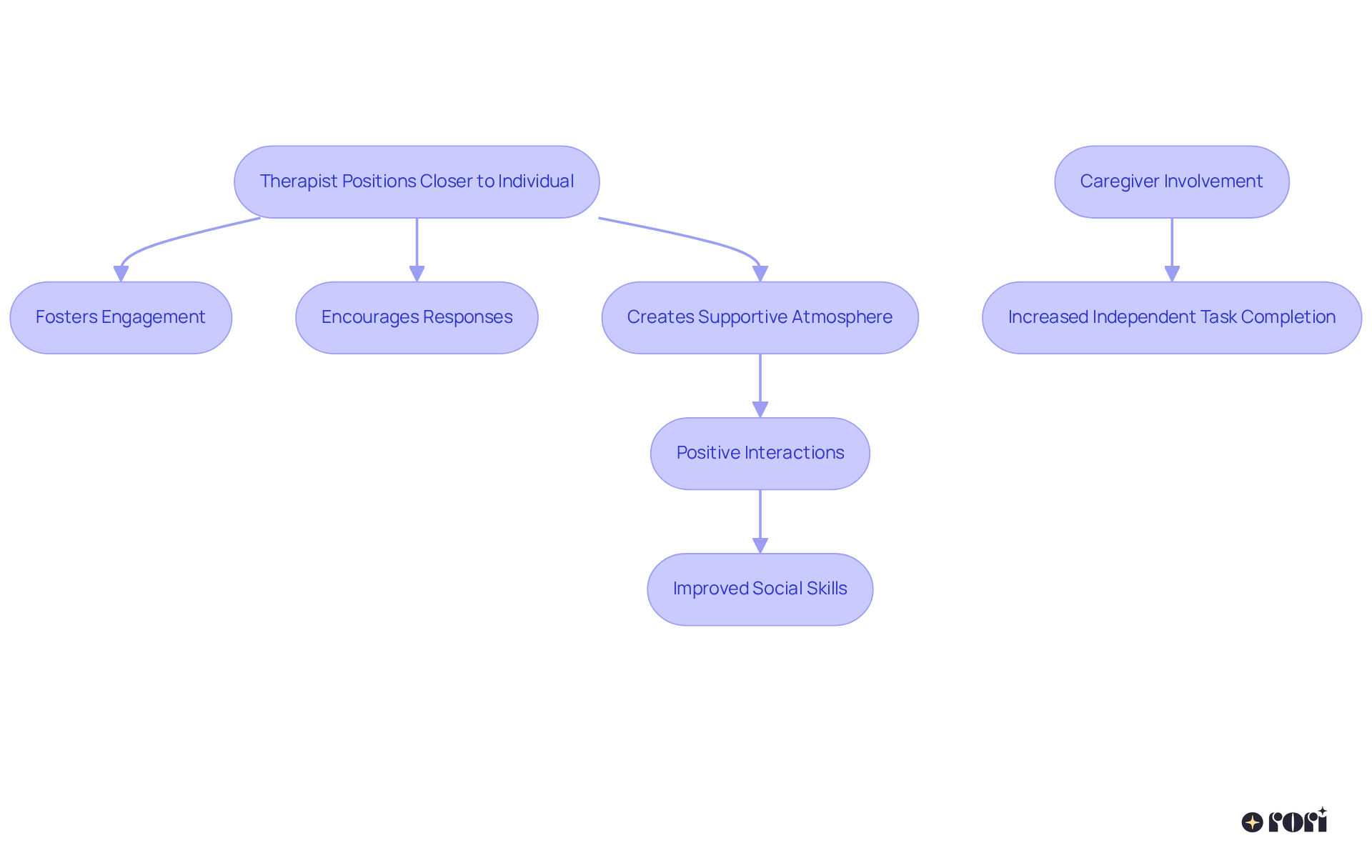
Visual cues, like pictures, symbols, or written guidance, can really help young learners by pointing them toward preferred actions. This not only makes their educational experience better but also more enjoyable! For example, picture schedules serve as a visual guide for daily activities, helping kids anticipate transitions and understand the order of events. Isn’t it great how this predictability fosters independence and eases anxiety by setting clear expectations? Research shows that visual supports can lead to a significant boost in on-task actions; one study even found that participants' engagement went up from an average of 40% to 60% when visual aids were used.
Integrating visual cues into therapy sessions, particularly through the use of a proximity prompt aba, creates a more engaging and adaptable learning atmosphere, especially for many kids with autism who thrive on visual learning. Visual supports like schedules and work systems are key components of the individualized plans crafted by skilled behavior analysts, particularly when incorporating the proximity prompt aba. These plans include measurable goals and evidence-based strategies aimed at positive behavior change. By providing structure and clarity, these tools empower young individuals to explore their environment with greater confidence, enhancing their overall treatment experience. Plus, when caregivers actively use these visual prompts, it reinforces therapeutic strategies, leading to better behavioral outcomes and a more supportive home environment. Let’s explore this together!
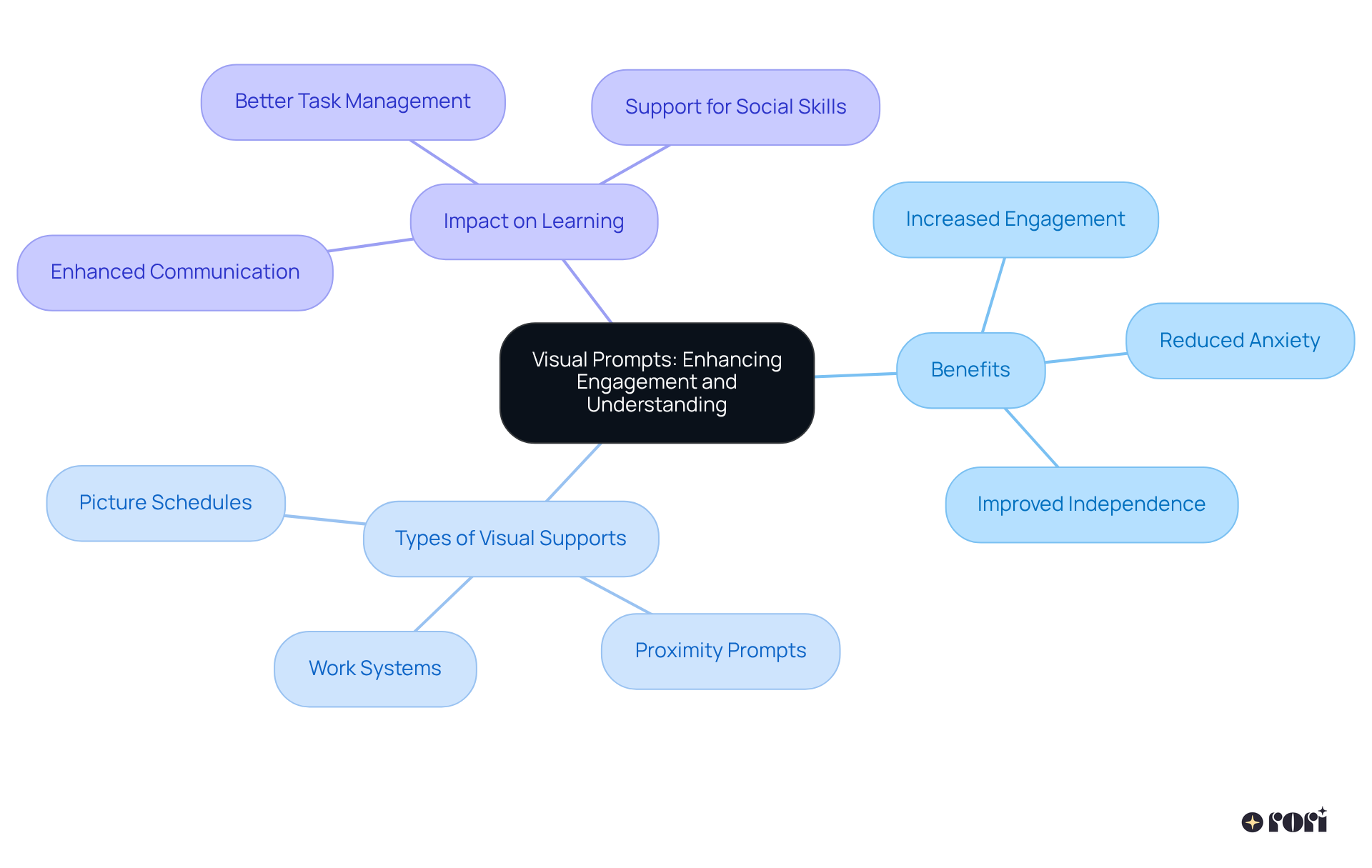
Modeling techniques play a crucial role in helping young individuals with autism navigate social interactions more effectively. This approach involves showcasing preferred actions for kids to observe and replicate, whether through live demonstrations by therapists or engaging video illustrations. For instance, when teaching a child to greet peers, the therapist first demonstrates the greeting, providing a clear example of what the interaction should look like. Interestingly, studies indicate that children with autism often respond more positively to video examples than in-person demonstrations, enhancing their ability to learn and imitate social behaviors.
The effectiveness of modeling is underscored by research showing that structured interventions, like video modeling, significantly boost social skills in young ones with autism. These strategies not only clarify expected actions but also foster a deeper understanding of social cues and interactions. By watching demonstrated actions, children can practice and internalize these skills, leading to better peer interactions and improved communication abilities.
Effective modeling methods also incorporate real-life scenarios in video presentations, helping kids visualize and practice social interactions. Additionally, using peer imitation techniques can further enhance learning outcomes, as children often learn best by observing their friends engage in social behaviors. Overall, modeling serves as a powerful tool in proximity prompt aba therapy, helping youngsters acquire the essential skills they need to thrive in social settings. Let’s explore this together!
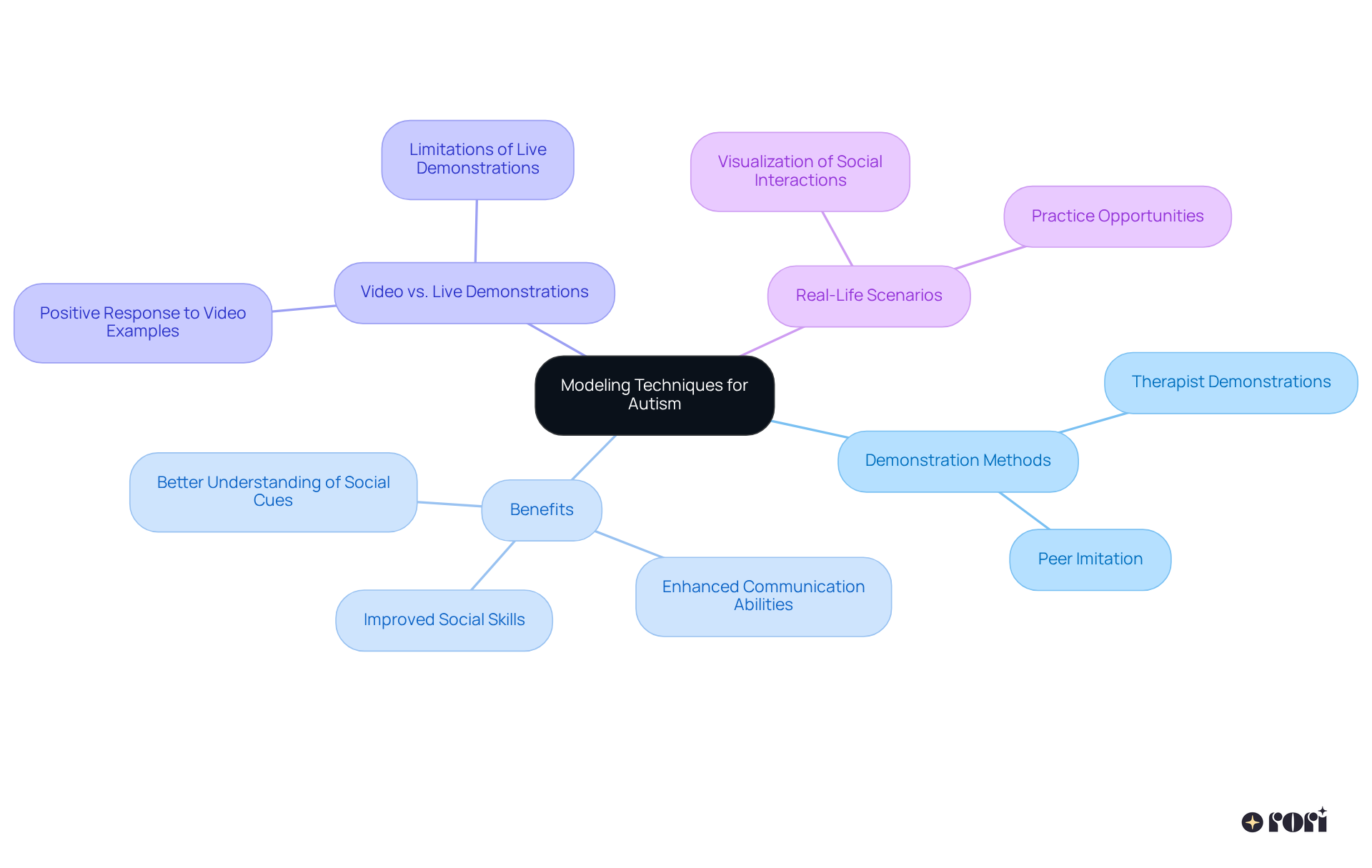
Natural Environment Teaching (NET) is all about helping young people learn in their everyday surroundings, like at home or in the community. Imagine a child asking for a snack during snack time at home—this real-life scenario makes learning so much more relevant! By weaving education into daily activities, NET not only boosts engagement and motivation but also helps kids retain what they learn. Studies show that young individuals learning in natural environments often show better adaptive skills and remember their behaviors longer, which is fantastic for autism treatment, especially when incorporating proximity prompt aba.
Now, let’s talk about the role of caregivers! Training them to implement behavioral interventions in these natural settings is super important. It emphasizes how vital family involvement is in the NET approach. When caregivers understand the proximity prompt aba strategies and principles, they can offer better support and make informed decisions, leading to improved behavioral outcomes. Plus, when education is integrated into real-world situations, it helps kids see how they can use their skills practically, resulting in meaningful and lasting changes.
And don’t forget about progress monitoring! Gathering data is essential for tracking how things are going and adjusting strategies to meet each individual’s changing needs. So, let’s explore this together! With the right tools and support, we can make a real difference in our children’s lives.
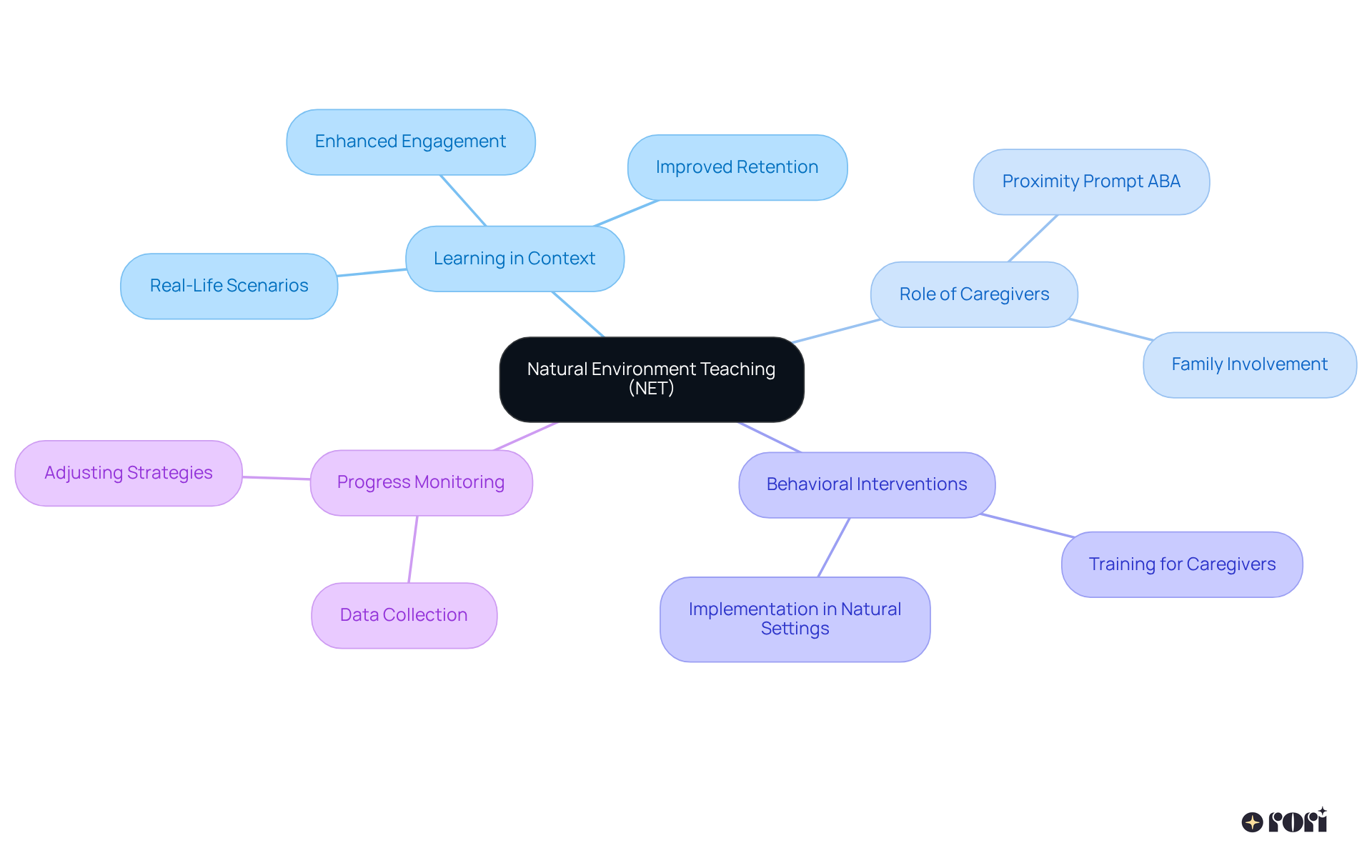
Verbal prompts are such helpful tools for guiding a young person's behavior through spoken cues or instructions. For example, a therapist might say, 'Can you show me how to wash your hands?' to encourage the child to get involved in the task. These prompts can be adjusted to match the young learner's understanding, from simple to more complex instructions. By using clear and concise verbal instructions, therapists can effectively lead young individuals through various activities, boosting their communication skills and encouraging independent responses over time.
This approach not only increases engagement but also helps develop essential life skills. Young individuals learn to express their needs and understand expectations in an organized way. The use of verbal prompts has been shown to significantly enhance communication skills, allowing young people to share their thoughts and needs more effectively. Adding visual cues alongside verbal prompts can further support language development, making learning even more effective. For instance, the Picture Exchange Communication System (PECS) is great for helping non-verbal individuals communicate using images, which complements verbal prompts beautifully.
Moreover, it’s essential to equip caregivers with strategies related to proximity prompt aba to support youth behavioral goals. Parent-led ABA solutions encourage families to actively participate in their child's therapy, highlighting the importance of teamwork in achieving positive outcomes. When caregivers are educated, they can provide consistent support at home, leading to better behavioral results and a deeper understanding of their child's needs.
Additionally, tracking progress clearly allows caregivers to see how effective verbal prompts are and adjust strategies as needed. This enhances the structured approach to therapy, particularly through the use of proximity prompt aba, making it even more effective. Let’s explore this together and see how these strategies can make a difference in your child’s development!
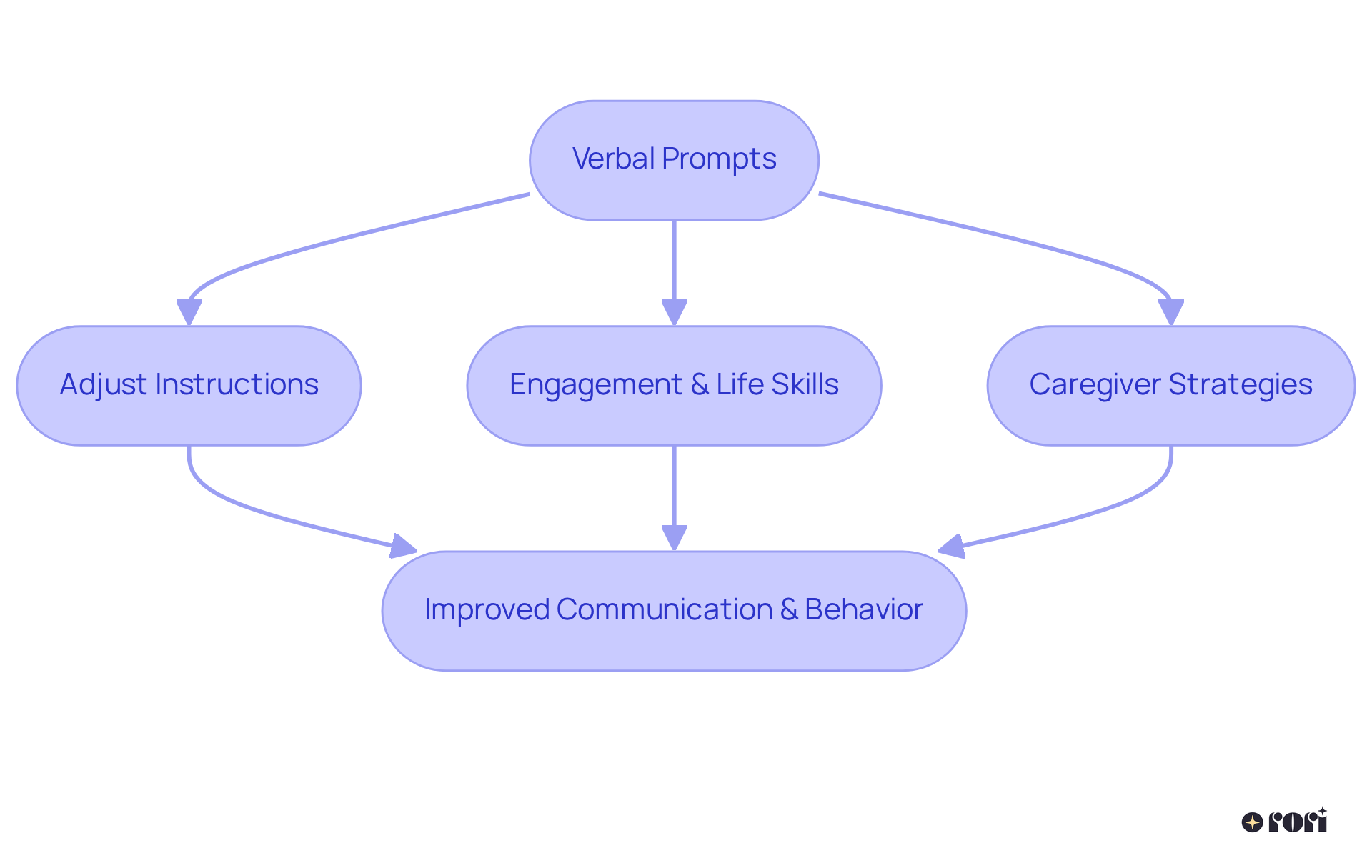
In proximity prompt ABA therapy, fading techniques are really important. They involve gradually reducing assistance as a young learner becomes more skilled at a task. For instance, a therapist might start with full physical prompts, then move to verbal prompts, and eventually eliminate prompts altogether. This gradual approach helps prevent prompt dependency, which can hinder a child's ability to develop skills and gain independence. Research shows that prompt dependency can slow down progress, so it's crucial to keep an eye on and adjust the level of support consistently.
As kids learn to tackle tasks on their own, they not only improve their skills but also feel more independent in their daily lives. To support this journey, qualified behavior analysts create personalized plans with clear objectives and evidence-based strategies tailored to each child's unique needs. These plans are regularly reviewed and adjusted based on progress reports, ensuring they remain responsive to the child's growth. Plus, having caregivers involved is key! When caregivers understand ABA principles and strategies, they can provide the right support at home, complementing professional interventions and promoting consistency.
Of course, challenges can arise, like when previously mastered skills start to slip away as prompts are faded. To address these challenges, educators should have a clear fading plan that incorporates the proximity prompt ABA, stay flexible, ensure consistency, gradually reduce prompts, collect data regularly, and encourage independent responses. As Steven Zauderer wisely points out, "Effective prompt fading is crucial; without it, young learners may struggle to acquire knowledge and execute tasks independently, resulting in possible reliance on prompts." By effectively applying fading techniques, therapists empower young learners to take charge of their education, building confidence in their abilities and improving overall behavioral outcomes. Let’s explore this together!
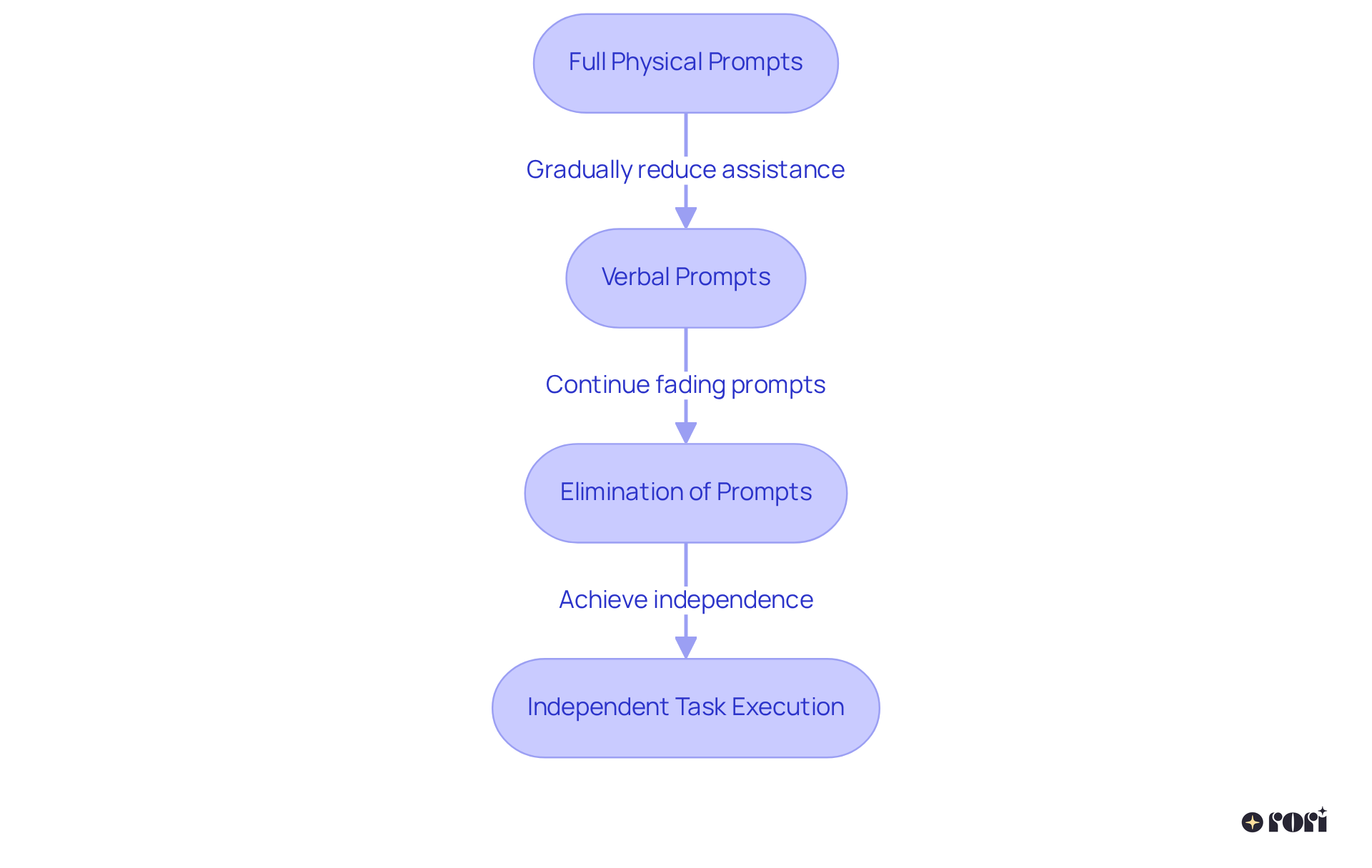
Peer modeling is such a fantastic approach! It brings together typically developing peers to show off desired actions for individuals with autism. This method allows young individuals to watch and mimic their peers in natural settings, which really boosts their interpersonal learning. For instance, during group therapy sessions focused on social skills, a peer might share a toy, encouraging the young participant to join in. Research shows that these peer-supported interventions lead to significant improvements in social skills. Many youngsters with autism report feeling more included in their communities and making deeper friendships as a result.
But the magic of peer interactions goes beyond just copying; it creates a warm and inclusive environment where young individuals learn from one another. Typically developing peer models often have more friends and are central to social networks, highlighting their positive influence in the classroom. Plus, structured peer modeling activities, like role-playing and group therapy, have proven to effectively enhance communication skills, helping youngsters start conversations and engage in back-and-forth interactions.
Incorporating peer modeling into therapy not only boosts social skills but also builds emotional resilience. Individuals learn to navigate social situations with more confidence. This collaborative learning experience empowers both those with autism and their neurotypical peers, fostering a supportive community that benefits everyone involved. And let’s not forget about caregiver education! It plays a crucial role by equipping parents with Applied Behavior Analysis (ABA) principles and strategies, such as the proximity prompt aba, to actively support their children’s goals through involvement and data collection.
Let’s explore this together! We’re here to help you every step of the way!
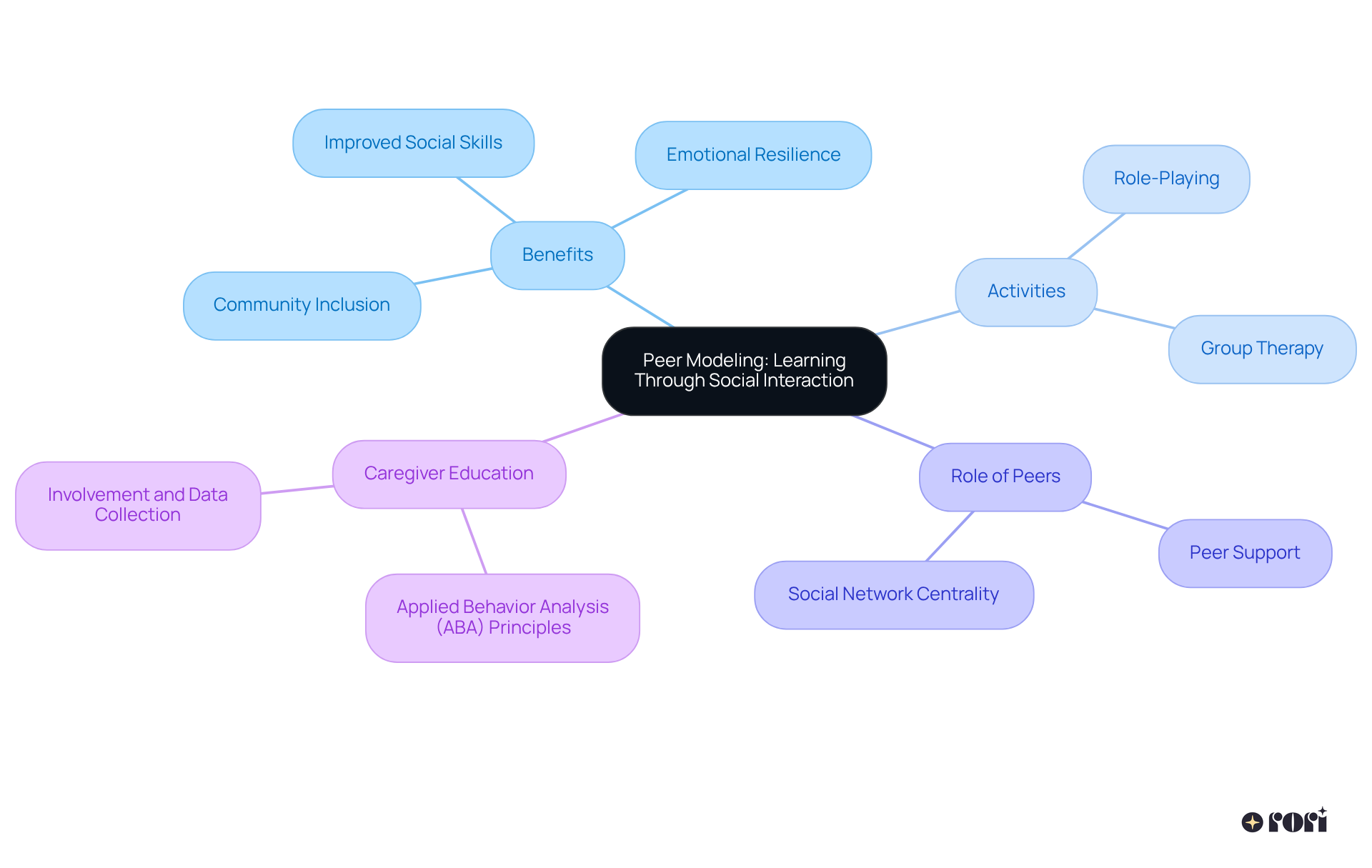
Task analysis is a fantastic way to break down complex tasks into smaller, manageable steps, making learning easier for individuals with autism. For example, when teaching a young child to tie their shoes, you can divide the process into simple steps like:
This structured approach allows kids to focus on one step at a time, reducing frustration and boosting their chances of success.
By simplifying the learning journey, task analysis not only helps children gain skills but also builds their confidence as they master each step. Research shows that this method can enhance communication skills by breaking interactions into sequential steps, leading to better social engagement. Plus, task analysis can improve daily living skills, like brushing teeth or getting dressed, by breaking these tasks down into clear, actionable steps.
The benefits of this approach extend beyond just quick learning; it promotes independence and helps young individuals tackle everyday challenges with ease. The primary goal of task analysis, especially when utilizing proximity prompt ABA, is to streamline the learning process, enhancing skill acquisition and independence, making it an essential tool in ABA therapy. This approach is part of a broader program development strategy created by qualified analysts, who design personalized plans with measurable objectives and evidence-based techniques tailored to each individual's unique needs.
Moreover, task analysis is crucial in Applied Behavior Analysis (ABA) therapy, especially when implementing proximity prompt ABA, to support individuals with autism in their learning and skill acquisition. Techniques like Forward Chaining, Backward Chaining, and Total Task Presentation can be effectively used within this framework to enrich the learning experience. Collaboration among analysts, educators, therapists, and caregivers is vital in customizing interventions to meet each child's specific needs, ensuring a comprehensive approach to skill development. By empowering caregivers with ABA principles and strategies, we can support children's behavioral goals through active involvement and data collection, ultimately leading to better outcomes. Let’s explore this together!
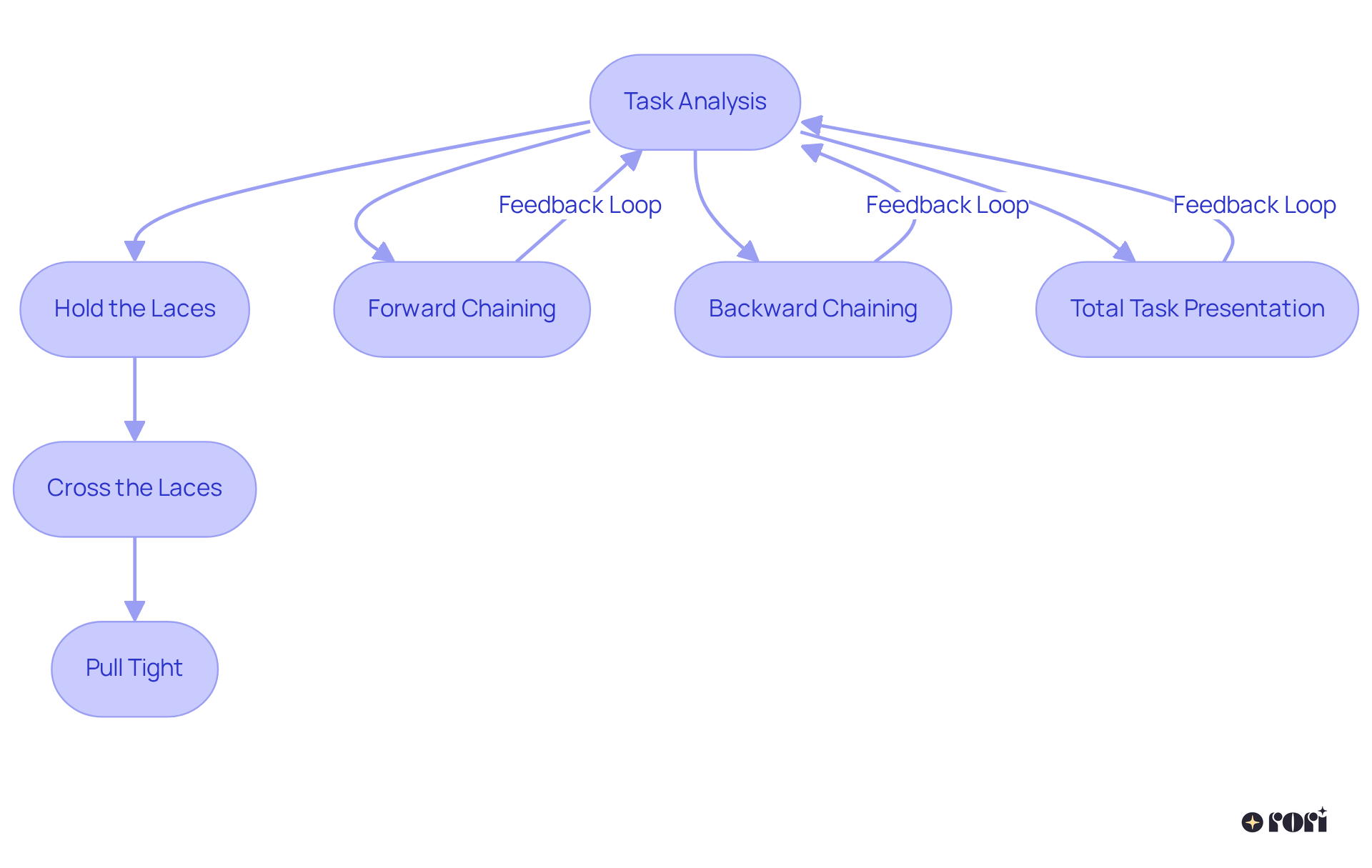
Positive reinforcement is such a powerful tool in Applied Behavior Analysis (ABA)! It’s all about giving a reward or incentive right after a desired action happens, which really boosts the chances of that action being repeated. For example, when a young person finishes a task, they might get some verbal praise or even a little treat like a sticker. This quick reinforcement not only encourages kids to engage in positive behaviors but also helps them connect their successes with great outcomes.
Qualified analysts play a crucial role in this process. They craft personalized plans filled with measurable goals and evidence-based strategies tailored to each child’s unique needs. These plans are regularly assessed and adjusted to keep up with the individual’s progress. Research shows that positive reinforcement can lead to significant improvements in behavior and skill development among youths with autism, enhancing their motivation, self-esteem, and participation in therapy. By consistently applying this approach, therapists create a nurturing environment that inspires kids to reach for success.
When it comes to using positive reinforcement effectively, it’s all about customizing the reinforcers to fit what each child enjoys—whether that’s social praise, tangible rewards, or natural reinforcers that come from their actions. Plus, having caregivers involved is essential! When caregivers learn about ABA principles and actively participate in the reinforcement process, they provide consistent support at home, which complements professional interventions and fosters overall progress. It’s also worth mentioning that ABA therapy is the only scientifically proven treatment for autism that insurance covers, making it accessible for many families.
The impact of positive reinforcement isn’t just about changing behavior in the short term; it encourages long-term growth in communication, social skills, and adaptive abilities. Research indicates that kids who receive prompt and specific reinforcement are more likely to develop crucial skills and improve their quality of life. By weaving these strategies into therapy, practitioners can truly help youth with autism achieve their goals and gain more independence. Let’s explore this together!
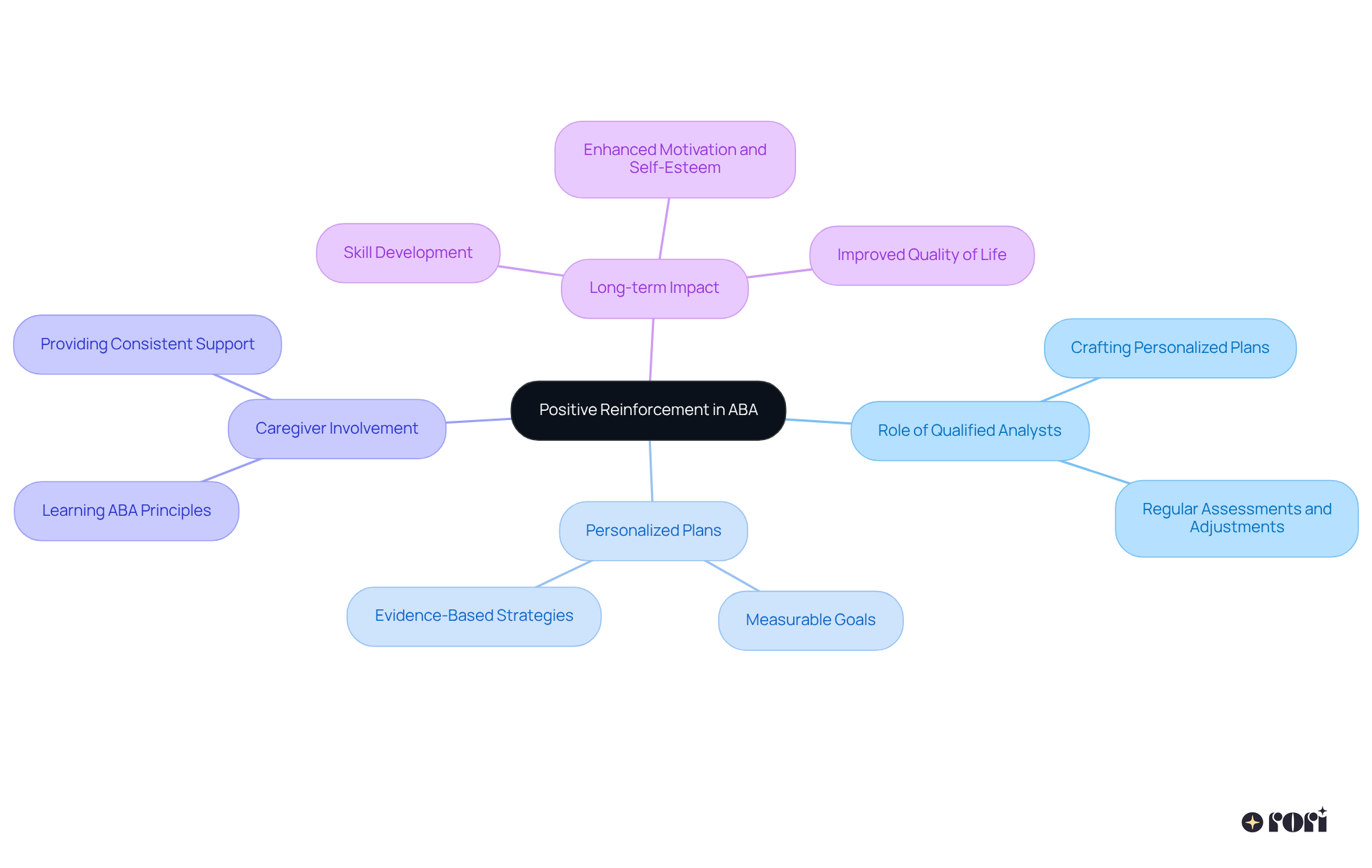
Gathering information in ABA therapy is so important for keeping track of a young person's actions and development! This process involves monitoring how often certain behaviors occur, how long tasks take, and how the young person responds to different prompts. By looking at this data, therapists—especially qualified behavior analysts—can make smart decisions about how well interventions are working and adjust treatment plans to fit each individual.
Consistent data gathering not only helps in tracking progress but also gives valuable insights into the learner's patterns, ensuring that therapy adapts to their changing needs. Parents often mention how crucial it is to assess outcomes like happiness, anxiety, and social communication skills, as these are key to understanding a young person's overall growth.
Moreover, effective data collection methods, such as using standardized assessment tools and video recordings, really boost the quality of assessments and encourage a collaborative approach between therapists and families. As we see a shift in autism care toward evidence-based practices, integrating data-driven decision-making becomes essential for optimizing treatment outcomes and supporting the development of young individuals.
Parents are encouraged to get involved in the data collection process! Discussing specific outcomes with therapists and thinking about how they can help track their child's progress can make a big difference. Let’s explore this together and ensure we’re doing everything we can to support our kids!
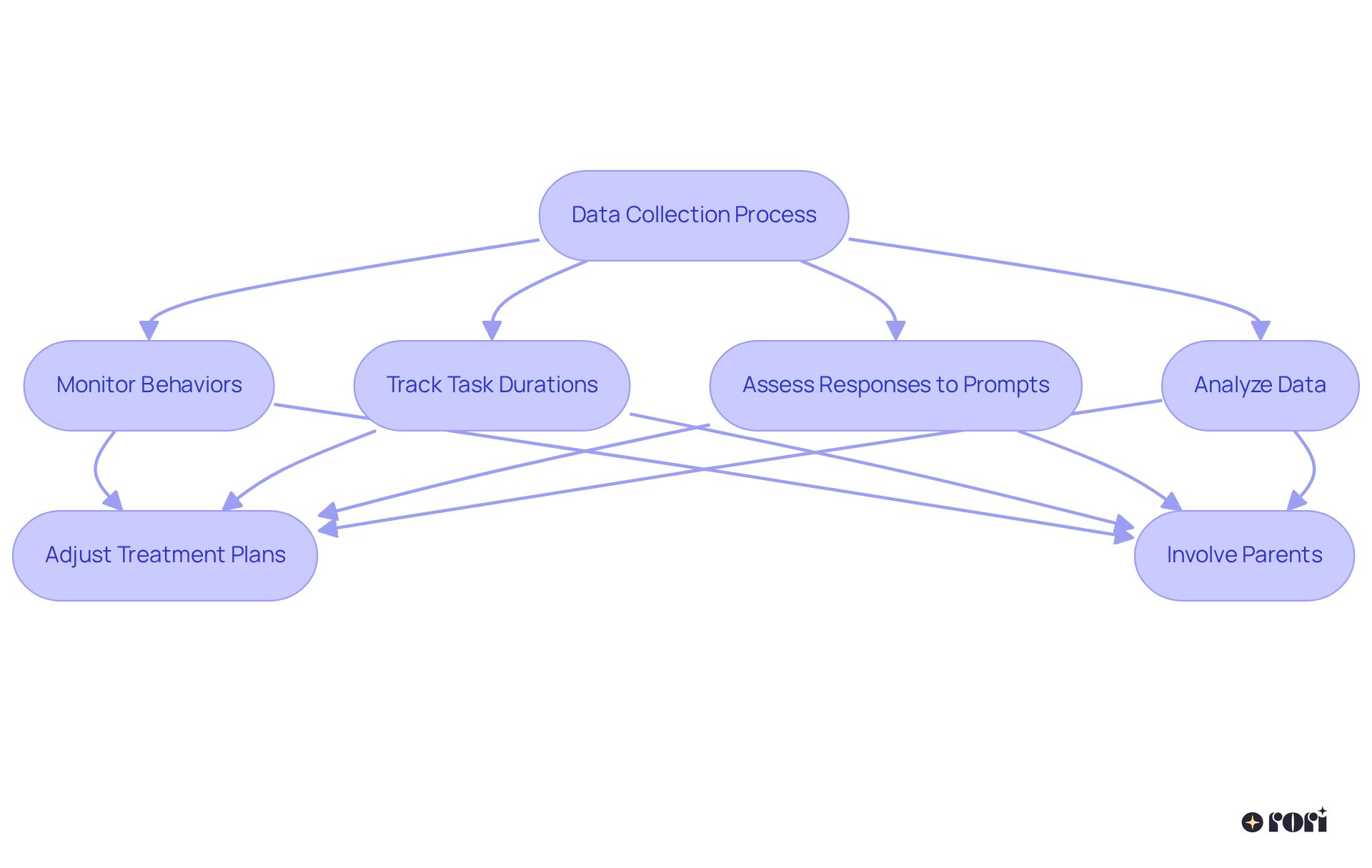
Proximity prompt ABA techniques are truly a cornerstone for enhancing learning and engagement in individuals with autism. By positioning caregivers and therapists closer to learners, these methods create a supportive environment that encourages interaction and promotes independence. The insights shared throughout the article highlight the transformative impact of these techniques, showing how they can significantly improve social skills, communication abilities, and overall developmental outcomes.
Let’s dive into some key strategies! Visual prompts, modeling techniques, and natural environment teaching each contribute uniquely to the learning process. Visual supports enhance engagement by providing clear expectations, while modeling techniques showcase behaviors for learners to imitate. Plus, incorporating learning within natural contexts helps solidify skills meaningfully, ensuring children can apply what they learn in real-life situations. Caregiver involvement and data collection are also vital, reinforcing that a collaborative approach enhances the effectiveness of these interventions.
Ultimately, integrating proximity prompting and related strategies in ABA therapy is essential for empowering young individuals with autism. By fostering independence, improving communication, and enhancing social skills, these techniques support immediate learning goals and lay the groundwork for long-term success. Engaging with these methods can lead to meaningful improvements in the lives of children and their families. So, let’s embrace these evidence-based practices together—after all, we’re here to help you every step of the way!
What is proximity prompting in ABA therapy?
Proximity prompting in ABA therapy involves positioning the therapist closer to the individual to foster engagement and encourage responses, creating a supportive environment that enhances learning.
How does proximity prompting benefit young individuals?
Proximity prompting boosts engagement and helps develop social skills. Research shows that with effective prompting strategies, independent transition moves can increase from below 20% to around 95%.
What role do qualified behavior analysts play in proximity prompting?
Qualified behavior analysts create personalized plans with measurable goals and evidence-based strategies tailored to each individual's needs, ensuring effective interventions that adapt to the learner's style.
How does caregiver involvement impact the effectiveness of therapy?
When caregivers are actively involved and recommended therapy hours are fully implemented, about 90% of children show notable progress, highlighting the importance of caregiver education for consistent support at home.
What are visual prompts and how do they enhance learning?
Visual prompts include pictures, symbols, or written guidance that help young learners anticipate transitions and understand the order of events, leading to increased engagement and reduced anxiety.
How do visual supports impact on-task behavior?
Research indicates that the use of visual supports can significantly boost on-task actions, with one study showing engagement increased from an average of 40% to 60% when visual aids were utilized.
What is the significance of modeling techniques in therapy?
Modeling techniques involve demonstrating preferred actions for children to observe and replicate, which helps them navigate social interactions more effectively and enhances their ability to learn social behaviors.
How does video modeling compare to in-person demonstrations for children with autism?
Studies show that children with autism often respond more positively to video examples than in-person demonstrations, which can enhance their learning and imitation of social behaviors.
What are the benefits of incorporating real-life scenarios in modeling?
Using real-life scenarios in video presentations helps children visualize and practice social interactions, leading to better peer interactions and improved communication abilities.
How does modeling support proximity prompt ABA therapy?
Modeling serves as a powerful tool in proximity prompt ABA therapy by helping children acquire essential social skills, as they learn by observing demonstrated actions and practicing them in social settings.